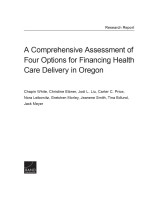| 来源类型 | Research Reports
|
| 规范类型 | 报告
|
| DOI | https://doi.org/10.7249/RR1662
|
| 来源ID | RR-1662-OHA
|
| A Comprehensive Assessment of Four Options for Financing Health Care Delivery in Oregon |
| Chapin White; Christine Eibner; Jodi L. Liu; Carter C. Price; Nora Leibowitz; Gretchen Morley; Jeanene Smith; Tina Edlund; Jack Meyer
|
| 发表日期 | 2017
|
| 出版年 | 2017
|
| 页码 | 147
|
| 语种 | 英语
|
| 结论 |
Projected Effects of Single Payer Option in 2020- Enrollment would increase.
- Financial barriers to accessing care would be significantly reduced for low- and middle-income individuals.
- Total health system costs in Oregon would not change much.
- Aggregate provider reimbursement would decrease.
- System congestion would increase.
- There are major hurdles to federal approval that might require federal legislation.
- Implementation would require significant changes to state administration and roles.
Projected Effects of Health Care Ingenuity Plan in 2020- Enrollment would increase.
- Financial barriers to accessing care would be reduced for low-income individuals.
- Total health system costs in Oregon would increase.
- Aggregate provider reimbursement would increase.
- System congestion would decrease.
- There are major hurdles to federal approval.
- Implementation would require potentially significant changes to state administration.
Projected Effects of Public Option in 2020- Enrollment would increase modestly.
- Financial barriers to accessing care would be slightly reduced.
- Total health system costs in Oregon would decrease.
- Aggregate provider reimbursement would decrease.
- System congestion would increase slightly.
- Federal approval would not face major hurdles.
- Implementation would be feasible.
|
| 摘要 |
- Should Oregon want to achieve universal coverage, Single Payer and the Health Care Ingenuity Plan (HCIP) are the most promising options. Adding a Public Option to the Marketplace will not expand coverage substantially over current levels.
- To effectively implement a Single Payer plan, Oregon should (1) prioritize discussions with federal government officials regarding the feasibility of the necessary waivers and seek legal counsel to determine whether an ERISA challenge is likely and how to avoid one, and (2) review CMS approaches to payment and seek input from providers to assess how payment changes could be enacted in a manner that promotes high-quality health care and maintains sufficient provider engagement.
- If Oregon wishes to pursue the HCIP approach, several important next steps would be to (1) identify and implement solutions to reduce the overall cost of HCIP, such as offering a public plan to compete with private plans or prohibiting or limiting supplemental coverage, and (2) work with federal policymakers to identify a mechanism for recouping the estimated $1.8 billion in new federal tax revenue that would result from wage passbacks.
- If state policymakers want to take a more incremental approach to change, the Public Option provides a step short of universal coverage that could have modest positive impacts and would be simpler to implement and less disruptive in the short term than the other two options assessed. Implementing a Public Option could be used as a step toward more expansive reform.
|
| 主题 | Affordable Care Act
; Health Care Financing
; Health Care Reform
; Health Insurance
; Medicaid
; Oregon
|
| URL | https://www.rand.org/pubs/research_reports/RR1662.html
|
| 来源智库 | RAND Corporation (United States)
|
| 引用统计 |
|
| 资源类型 | 智库出版物
|
| 条目标识符 | http://119.78.100.153/handle/2XGU8XDN/108503
|
推荐引用方式
GB/T 7714 |
Chapin White,Christine Eibner,Jodi L. Liu,et al. A Comprehensive Assessment of Four Options for Financing Health Care Delivery in Oregon. 2017.
|
|
文件名:
|
x1495316354550.jpg
|
|
格式:
|
JPEG
|

|
文件名:
|
RAND_RR1662.pdf
|
|
格式:
|
Adobe PDF
|
此文件暂不支持浏览
除非特别说明,本系统中所有内容都受版权保护,并保留所有权利。